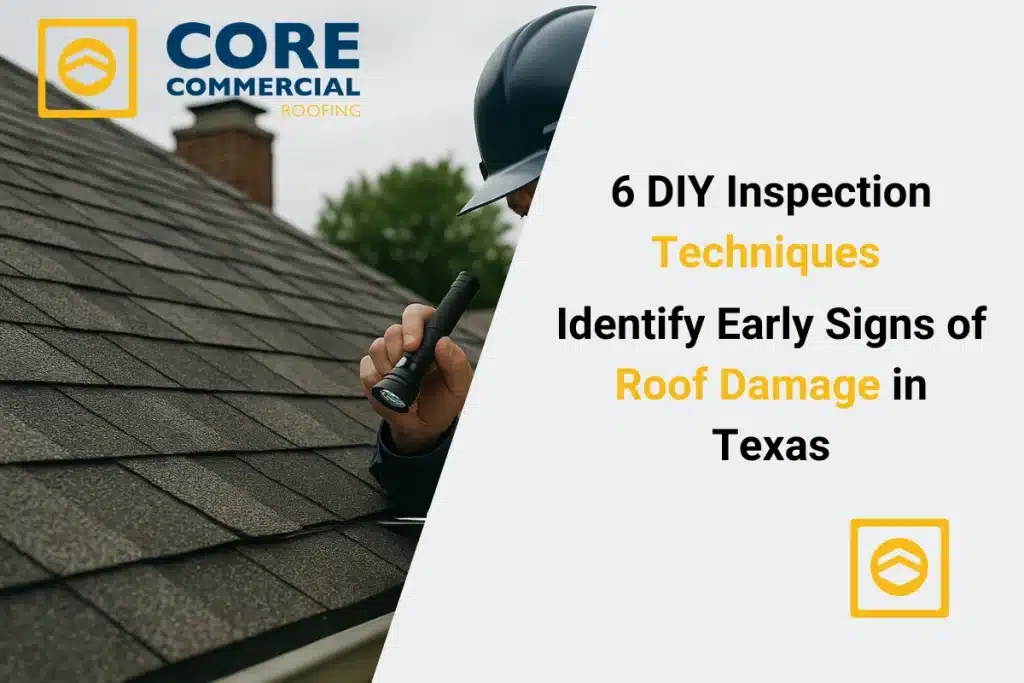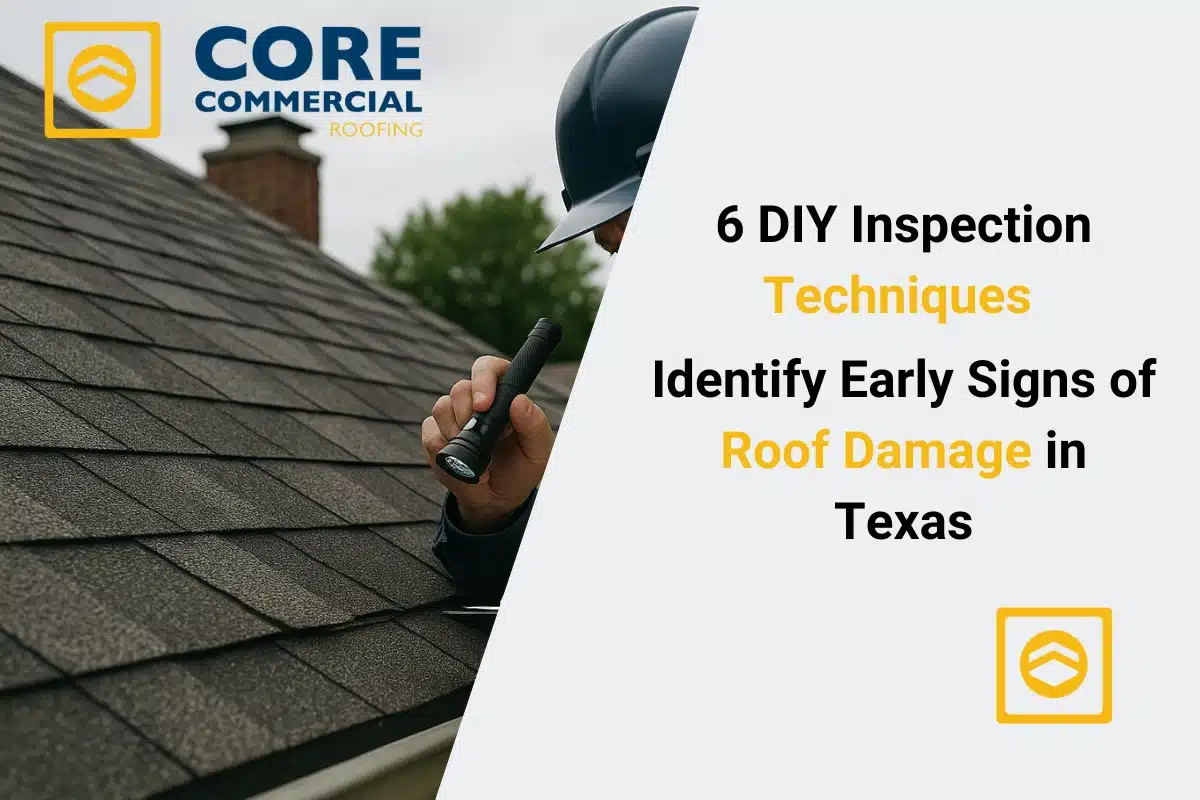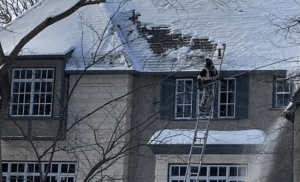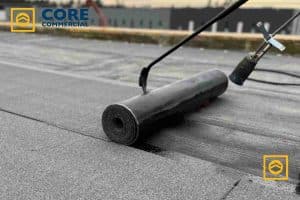Texas roofs face some of the toughest conditions in the country. scorching heat, sudden hailstorms, and powerful winds. Over time, even the smallest weakness can lead to big problems like leaks, structural rot, and costly repairs. Learning how to identify roof damage early is the best way to protect your home and budget. One method we always find incredibly effective is a roof storm damage inspection right after severe weather. Because that’s when hidden problems are most likely to show up. By catching these early, you can stop small issues before they grow into full-blown roof replacements. In this guide, you’ll learn six practical, do-it-yourself techniques that any Texas homeowner can use to keep their roof in top shape. And why acting fast can save you thousands.

Table of Contents
Start With a Ground-Level Roof Damage Inspection
Before climbing ladders or risking injury, begin by surveying your roof from the ground. This first step is both safe and surprisingly effective for spotting early signs of trouble.
What to Look For:
- Missing or misaligned shingles – Storm winds can lift or blow away shingles, leaving the roof deck exposed.
- Dark patches or streaking – These could signal algae growth, moisture intrusion, or aging shingles.
- Sagging rooflines – A drooping section may point to water damage or structural stress.
Why It Matters:
Catching visible issues from a distance gives you an early warning without needing to set foot on the roof. In Texas, where high winds and sudden storms are common, a quick ground-level check after severe weather can prevent bigger problems.
Pro Tip: Use a camera with a zoom lens or binoculars to get a detailed look while keeping your feet on the ground.
How to Spot Roof Damage After Texas Storms
Storms in Texas can be brutal, with hail, heavy rain, and strong gusts that stress every part of a roofing system. A roof storm damage inspection right after these events can uncover problems that might otherwise go unnoticed.
Steps to Take:
- Check the perimeter for fallen shingles or flashing pieces.
- Use a ladder (with a helper) to inspect edges for cracks, curling, or lifted shingles.
- Look inside gutters for loose shingle granules—a sign of wear or hail impact.
Why It Matters:
A small tear in a shingle can let water seep in, leading to rot, mold, and structural decay. Texas humidity and temperature swings accelerate this process, making quick inspections essential.
Roof Damage Assessment: Checking Flashing Around Chimneys, Vents, and Skylights
Flashing—the thin metal barrier that seals roof joints—is often a hidden weak point. Extreme Texas heat causes expansion and contraction that can loosen or warp these components.
Signs of Trouble:
- Rust or corrosion spots
- Gaps where flashing meets brick, vent pipes, or skylight frames
- Water stains on the interior ceilings near these features
Why It Matters:
Loose or damaged flashing is one of the top causes of leaks. A thorough roof damage assessment should always include checking flashing integrity, both from the outside and inside.
Tip: If you see daylight peeking through around vents when inside your attic, that’s a red flag for potential leaks.
Why Gutters and Downspouts Are Part of Your Roof Damage Report
It’s easy to think of gutters as separate from your roof, but they play a vital role in moving water safely away from your home. Problems here often indicate roof trouble above.
Inspection Checklist:
- Look for shingle granules (black, sand-like particles) in the gutters.
- Check for sagging or detachment from the fascia.
- Ensure water flows freely through downspouts without pooling near the foundation.
Why It Matters:
Granule loss suggests shingle aging or storm damage. Poor drainage can back up water under roofing materials, causing rot and leaks. For a thorough roof damage report, note all gutter issues, as they often lead to—or come from—roof problems.
Attic Checks for Moisture and Hidden Roof Leaks
Some of the most dangerous roofing problems are invisible from the outside. That’s why a complete roof damage inspection includes checking the attic.
What to Look For:
- Damp insulation or wooden rafters
- Mold or mildew growth
- Sunlight shining through the roof boards
Why It Matters:
Moisture in the attic is a strong indicator that water is penetrating your roof system. Over time, this can lead to costly structural repairs and health hazards from mold.
Safety Tip: Wear gloves and a mask when working in dusty or damp attics.
Energy Bill Changes as a Sign of Roof Problems
An unexpected rise in your energy bills, especially cooling costs, can be a subtle warning sign of roof issues.
Common Causes:
- Damaged or missing insulation from roof leaks
- Gaps or holes letting in hot air during Texas summers
- Ventilation issues that cause uneven heating or cooling
Why It Matters:
Poor roof insulation forces your HVAC system to work harder, which increases energy costs and shortens system lifespan. Catching these issues early can save money both on repairs and utilities.
How to Document Your Findings for a Roof Damage Report
If you plan to file an insurance claim or request a professional opinion, clear documentation is key.
Best Practices:
- Take clear photos from multiple angles.
- Keep a dated log of inspections and findings.
- Note specific locations (e.g., “northwest corner, near chimney”).
A detailed roof damage report not only speeds up insurance claims but also helps professionals recommend the right repairs or replacements.
When to Call for a Commercial Roof Inspection or Repair
While this article focuses on DIY residential techniques, the same inspection principles apply to businesses. For flat or low-slope roofs, issues like pooling water, seam separation, and membrane punctures require immediate attention.
Why Businesses Should Act Fast:
- Leaks can damage inventory, equipment, and interiors.
- Regular commercial roof inspection services can prevent unexpected shutdowns.
- Early commercial roof leak repair is always more affordable than full replacement.
If your building uses specialized commercial roofing systems, it’s critical to have them inspected by professionals who understand their unique requirements.
Bonus Prevention Tips for Texas Roofs
- Schedule seasonal inspections—especially after hailstorms or high winds.
- Trim overhanging branches to reduce debris and impact damage.
- Clean gutters regularly to maintain water flow.
- Know your insurance coverage for storm damage and keep inspection records up to date.
Conclusion and Next Steps
Roof damage inspection isn’t just about preventing leaks—it’s about protecting your entire home. By learning how to identify roof damage early, you can avoid surprise expenses, extend your roof’s life, and maintain your property’s value. These six DIY techniques—paired with proper documentation and timely professional help when needed- will keep you ahead of Texas’s unpredictable weather. Whether you’re maintaining a family home or overseeing commercial roofing systems, a proactive approach is always your best defense.
FAQs
How to check my roof for storm damage in Texas?
After a storm, walk around your home and look for missing shingles, dents on vents, or debris in gutters. Check your attic for water stains or leaks. If you find any issues, consider contacting a local roofing professional for a thorough inspection.
What are the signs of roof damage after a Texas hailstorm?
Signs include dents on metal parts, granules in gutters, cracked or missing shingles, and leaks inside your home. Hail can cause significant damage that’s not always visible from the ground.
How can I tell if my Texas roof has wind damage?
Look for lifted or missing shingles, loose flashing, and debris on the roof. Inside, check for water stains on the ceilings. Wind can cause shingles to loosen or blow off entirely.
What should I look for in a DIY roof inspection in Texas?
Check for missing or damaged shingles, clogged gutters, rusted flashing, and signs of leaks in the attic. Regular inspections can catch problems early.
How often should I inspect my roof in Texas?
It’s recommended to inspect your roof at least twice a year, in the spring and fall, and after major storms. Regular checks help prevent costly repairs.
Can I inspect my roof without climbing up?
Yes, you can use binoculars to look for visible damage from the ground. Also, check your attic for signs of leaks or water damage. For a thorough inspection, consider hiring a professional.
What are the early signs of roof leaks in Texas homes?
Early signs include water stains on ceilings, mold or mildew in the attic, and damp insulation. Addressing these signs promptly can prevent further damage.
How do Texas storms affect my roof’s lifespan?
Frequent storms can wear down roofing materials, leading to leaks and structural issues. Regular maintenance and inspections can extend your roof’s life.
Is it safe to do a DIY roof inspection in Texas?
If you’re comfortable and have the right equipment, you can perform a basic inspection. However, for safety and thoroughness, hiring a professional is advisable.
What tools do I need for a DIY roof inspection?
You’ll need a sturdy ladder, binoculars, a flashlight, and a camera. Safety gear like gloves and non-slip shoes is also important for your protection.






